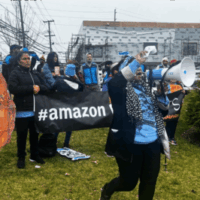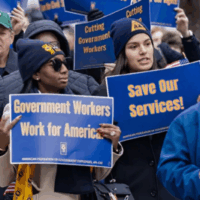Nationwide — The unemployment rate was steady at 3.8% in September according to the Bureau of Labor Statistics. The economy gained 336,000 jobs. The unemployment rate for Black workers was 5.7%, significantly higher than the 3.4% unemployment rate for white workers. These disparities are a result of structural racism in the U.S. labor market.
“Unemployment remains at historically low levels, yet many jobs still don’t provide the pay, benefits, and working conditions that workers and their families need to flourish,” said Rebecca Dixon, president and CEO of the National Employment Law Project. “For decades, wages have barely increased despite rising productivity and skyrocketing corporate profits. A crucial way to build a good jobs economy is for workers to organize and stand together. That’s why workers—from actors to autoworkers to hotel housekeepers and hospital workers—are going on strike to improve their jobs, often at great personal risk.”
In August 2023, workers were on strike for more days than any other month in the past two decades. Workers are winning notable gains through strikes and the threat of strikes. For example, the Teamsters’ historic UPS contract secured substantial raises and improved working conditions, including protection from extreme heat that is essential for safe work in the midst of a climate crisis. The tentative deal negotiated by the Writers’ Guild of America would significantly increase pay for streaming content and provide security from the use of artificial intelligence. Teachers and other school staff in Oakland won not only raises but agreements to provide robust services to students and families, with a particular focus on supports for homeless students and for schools with predominantly Black students, a step toward reparations for generations of discrimination.
Yet workers often make considerable economic sacrifices to go on strike. In most states, striking workers are not eligible for unemployment benefits. The exceptions are New York and New Jersey, which provide UI benefits after a strike has lasted for 14 days. These states offer a model, and the neighboring states of Connecticut and Massachusetts are also considering expanding UI benefits to some striking workers. Unfortunately, despite strong evidence that extending unemployment insurance to striking workers would benefit families, communities, and the larger economy in California, Governor Gavin Newsom recently vetoed a bill to provide benefits. As NELP senior staff attorney Jenna Gerry points out, there are multiple reasons why reforming unemployment insurance is essential to building worker power.
The growth of average earnings continued to slow in September, highlighting one reason why so many workers are willing to risk going on strike.
The September unemployment rate was 4.6% for Latinx workers, a decrease from 4.9% in August. Asian workers’ unemployment rate was 2.8%, a decrease from 3.1% in August.
Policymakers must act to build an unemployment insurance system that will support all workers at all times, including workers exercising their right to strike. This includes establishing minimum federal standards for UI eligibility, benefit duration, and benefit adequacy that all state unemployment systems must meet; ensuring equitable access to UI benefits; modernizing and reforming the Extended Benefits program; and establishing additional emergency UI programs that automatically trigger on during periods of high unemployment. This also includes adequate and sustained funding for UI administration, oversight, and IT modernization, which is essential to ensure timely and accurate payments. A transformed unemployment insurance system will strengthen the economy and enable all workers to thrive.
Related to
The Latest News
All newsMayor Bowser & D.C. Council Must Respect the Will of D.C. Voters by Rejecting Repeal of Initiative 82

Blog
New Brief Sheds Light on the Amazon’s Dangerous ‘Flex’ Labor Model

News Release
NELP Denounces Supreme Court Ruling Permitting Immediate Layoffs of Hundreds of Thousands of Federal Workers

News Release
